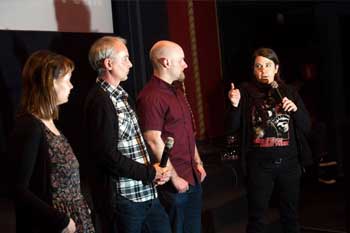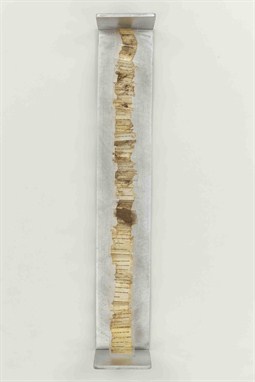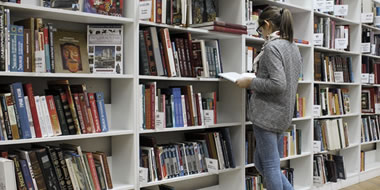Below you will find the latest event and lecture series for the Visual and Material Research Culture Group 2016/2017.
Header Image: Liberate Tate intervention, Martin LeSanto-Smith, 2015
10 May “Horribly academic? Genre film festivals and academia”
Date: 10 May, 2017
Time: 4:00 pm
Location: Squires Annexe 203

Presenter: Russ Hunter, Senior Lecturer, Film & Television, Northumbria University
There are more than one-hundred horror, cult and fantastic film festivals held in Europe on an annual basis, with the twenty-two festivals of the European Fantastic Film Festivals Federation alone boasting an overall annual attendance of more than 450,000 visitors. Dirk van Extergem (2004) articulates this preference for genre cinema as cultivating and providing for an audience that have a love for ‘bad’ films as well as ‘good’ ones, and therefore providing a genuine alternative to the commonly accepted formula of the film festival. The genre film is a key part of providing that alternative as not only is it loosely defined and inclusive of many popular forms, but it has also endured dismissal as ‘unworthy’ of serious consideration for many years. This talk will explore my recent work with Abertoir Horror Festival (Aberystwyth, Wales), Offscreen (Brussels, Belgium) and Kurja Polt (Ljubljana, Slovenia), examining how the participation of academics has impacted upon these festivals in a variety of ways. It will look at how the nature of this involvement has led to the development of an Impact Case Steady for REF2020 that builds upon a previous case successful case study for REF 2014.
Bio : Russ Hunter is a Senior Lecturer in Film & Television at the University of Northumbria. His research is focused upon genre film festivals, Italian genre cinema, European horror cinema and critical reception. His most recent publication is Italian Horror Cinema (Edinburgh University Press, 2016) and his monograph, An Introduction to European Horror Cinema is due to be published with Edinburgh University Press in 2017.
29 March: "Could I introduce the meanings of this body?[...]Could I make it insist upon meanings conventionally resisted?"

Date: 29 March, 2017
Time: 4:00 pm
Location: LIP033
Presenter: Victoria Horne, Lecturer, Art and Design History, Northumbria University
Carolee Schneemann (b.1939) performed Interior Scroll twice. In 1975 at an exhibition of women’s art in East Hampton and, subsequently in 1977, as an unplanned intervention at Telluride Film Festival in Colorado. Both performances consisted of Schneemann removing her clothing, painting upon her naked body, adopting a sequence of static poses, reading from her 1976 book Cézanne She Was a Great Painter, and notoriously culminated in the removal of a scroll from her vagina, which she read aloud to the audience. The artist described the unfurling scroll, which she addressed to other women, ‘like ticker tape, rainbow…plumb line… the umbilicus and tongue’.
Interior Scroll has since entered the canon of twentieth-century performance art; photographs of the performance have been reproduced in textbooks and collected by major museums. However, little attention has been paid to Schneemann’s unusually active role in the management of these images, nor her assertive control of the work’s critical meanings. It emerges in studying the reception history of Interior Scroll that Schneemann’s performed, written, and spoken words have dictated the discourse – a significant observation in light of coincident discussions on feminist politics, women’s creativity, and history agency.
This paper focusses on the themes of embodiment, labour and knowledge; ideas that are concretised in Schneemann’s performance and subsequent authorial interventions. Given current attacks on women’s reproductive rights, bodies and lives, it is instructive to revisit Schneemann’s powerful performance, remembering Susan Gubar’s significant observation that ‘…the female body has been feared for its power to articulate itself’.
Bio: Victoria Horne is a Lecturer in Art and Design History at Northumbria University. Her writing on feminism and art has been published in Journal of Visual Culture, Feminist Review, Radical Philosophy and (forthcoming) Third Text. A co-edited volume of essays will be published this summer, entitled Feminism and Art History Now.
1 March: "Art Organisation"
 Date: 1 March, 2017
Date: 1 March, 2017
Time: 5:00 pm
Location: LIP121
Presenter: Julie Crawshaw, Lecturer, Creative & Cultural Industries, Northumbria University
'Artist-led’ is a term used to denote art practices mobilised beyond artworks to making, for example, living spaces, studios, galleries and other modes of exhibitionary or distributive projects. How do these works ‘work’? What do they mobilise?
In the literature of art practice the term ‘artist-led’ (alongside related terminology, including self-organisation, alternative, non-profit and artist-run) is most often discussed in relation to the art institution and institutional theories of the art world. In practice, the work takes place in multiple fields of social practice, as related to planning and organisation studies. Despite increased interest in what art does there is little pollination, however, between artist-led discourse and these arenas. To consider artist-led projects in relation to planning and organisation processes, this paper contributes an ethnographic study of artist-led practice across Sweden, including farming, scrapyard redevelopment and gallery exhibition making.
Funded by the Swedish Research Council, this research is part of ‘Stretched: Expanded notions of artistic practice through artist-led cultures’, Valand Academy, University of Gothenburg. http://akademinvaland.gu.se/english/research-/research-projects/stretched
BIO: Julie Crawshaw is an art anthropologist with an experimental practice developed through an interdisciplinary pathway. In tandem with artists, planners, community members and others, her research explores human non-human relations towards making future plans. Before academia she worked in arts management with particular interest in the role of art in social contexts and artist-led practice. This professional experience closely informs her academic work as combining scholarship and engagement. She is a Lecturer in Art and Design History at Northumbria University. https://www.northumbria.ac.uk/about-us/our-staff/c/julie-crawshaw/
25 Jan: "A People’s Photography: Researching Photographic Practices in Orkney and Shetland"
 Date: 25 January, 2017
Date: 25 January, 2017
Time: 5:00 pm (revised time)
Location: LIP 121 (revised location)
Presenter: Rupert Ashmore, Senior Lecturer, Art & Design History, Northumbria University
Rupert will talk about his current research into historic and contemporary photography in Orkney and Shetland. As photographic historian Tom Normand points out, the majority of Scottish photography until the 1970s was driven by commercial, press and amateur practices, rather than the avant-garde and documentary impulses seen in England, Europe and the USA. However, this “vernacular” photography was just as effective in establishing narratives of what Scotland was and is, and those narratives were often refreshed as much as challenged when a home-grown documentary movement began to focus on social issues from the 1970s onwards. Vernacular photography is now highly accessible through public exhibitions, online museum archives, “Town X in Old Photographs” publications, and social media groups, and closer inspection complicates binaries of art / commerce, amateur / professional, and those accepted narratives of identity. Rupert will outline some of the challenges of, and approaches to unpicking this vast vernacular, documentary and artistic archive of “people’s photography”.
BIO: Rupert is an art and design historian whose research spans fine art, photography, film and digital communications media. He completed his doctoral thesis in 2011, examining the filmic and photographic portrayal of the 2001 Foot and Mouth Disease epidemic and the collapse of the County Durham mining industry from the late 1970s. His research examines the use of visual media to construct and disseminate narratives of cultural memory, and enrich spaces with meaning and value in northern British and European communities. From 2012 he has been investigating photographic, film and internet media in Scotland’s Northern Isles.




 Date: 1 March, 2017
Date: 1 March, 2017  Date: 25 January, 2017
Date: 25 January, 2017
 Talk by Michael Johnson:
Talk by Michael Johnson: Keeping the bits alive: authenticity and longevity for digital art
Keeping the bits alive: authenticity and longevity for digital art "Technology advanced treatments for the conservation of traditional and modern paintings"
"Technology advanced treatments for the conservation of traditional and modern paintings" 'Saints in Glass'
'Saints in Glass' “Recent and future projects: 19th and 20th century architecture”
“Recent and future projects: 19th and 20th century architecture” "Transnational Textiles: New Directions” The Design History Symposium
"Transnational Textiles: New Directions” The Design History Symposium “Geek Chic ? The Design of National Health Service glasses and questions of Identity”
“Geek Chic ? The Design of National Health Service glasses and questions of Identity” "Heritage as Process"
"Heritage as Process" "Slave Trade to Fair Trade: Change and Development in Philanthropy and Craft"
"Slave Trade to Fair Trade: Change and Development in Philanthropy and Craft" Celebrating the work of Dr Malcolm Gee
Celebrating the work of Dr Malcolm Gee



